The Effect of the COVID-19 Pandemic on the Distribution of Traffic Accident Hotspots in New York City
Abstract
1. Introduction
2. Literature Review
2.1. Traffic Accident Hotspots
2.2. The Influence of the COVID-19 Pandemic on Traffic Accidents
3. Materials and Methods
3.1. Research Area
3.2. Data
3.2.1. Resident Mobility Data
3.2.2. Traffic Flow Data
3.2.3. Traffic Accident Data
3.3. Methods
3.3.1. Kernel Density Estimation Method
3.3.2. Getis-Ord Gi* Method
4. Results
4.1. The Influence of the COVID-19 Pandemic on the Mobility of Residents
4.2. The Influence of the COVID-19 Pandemic on Urban Traffic Accidents
5. Discussion
Author Contributions
Funding
Institutional Review Board Statement
Informed Consent Statement
Data Availability Statement
Conflicts of Interest
References
- Global Status Report on Road Safety 2018. 2018. Available online: https://www.who.int/publications/i/item/9789241565684 (accessed on 12 January 2024).
- Abdel-Aty, M.A.; Radwan, A.E. Modeling traffic accident occurrence and involvement. Accid. Anal. Prev. 2000, 32, 633–642. [Google Scholar] [CrossRef] [PubMed]
- Singh, H.; Kathuria, A. Analyzing driver behavior under naturalistic driving conditions: A review. Accid. Anal. Prev. 2021, 150, 105908. [Google Scholar] [CrossRef] [PubMed]
- Wang, C.; Xie, Y.; Huang, H.; Liu, P. A review of surrogate safety measures and their applications in connected and automated vehicles safety modeling. Accid. Anal. Prev. 2021, 157, 106157. [Google Scholar] [CrossRef]
- Arun, A.; Haque, M.M.; Bhaskar, A.; Washington, S.; Sayed, T. A systematic mapping review of surrogate safety assessment using traffic conflict techniques. Accid. Anal. Prev. 2021, 153, 106016. [Google Scholar] [CrossRef] [PubMed]
- Zheng, L.; Sayed, T.; Mannering, F. Modeling traffic conflicts for use in road safety analysis: A review of analytic methods and future directions. Anal. Methods Accid. Res. 2021, 29, 100142. [Google Scholar] [CrossRef]
- Rosenthal, D.M.; Heys, M.; Schoenthaler, A.; Hayward, A.; Ucci, M.; Lewis, C. How did living in temporary accommodation during the COVID-19 pandemic affect children younger than 5 years’ access to health care and health outcomes? A qualitative study of key professionals in a socially and ethnically diverse and deprived area of London. Lancet 2022, 400, S75. [Google Scholar] [CrossRef] [PubMed]
- Shew, A. Let COVID-19 expand awareness of disability tech. Nature 2020, 581, 9–10. [Google Scholar] [CrossRef] [PubMed]
- Harirforoush, H.; Bellalite, L. A new integrated GIS-based analysis to detect hotspots: A case study of the city of Sherbrooke. Accid. Anal. Prev. 2019, 130, 62–74. [Google Scholar] [CrossRef] [PubMed]
- Sarkar, C.; Webster, C.; Kumari, S. Street morphology and severity of road casualties: A 5-year study of Greater London. Int. J. Sustain. Transp. 2018, 12, 510–525. [Google Scholar] [CrossRef]
- Dagaeva, M.; Garaeva, A.; Anikin, I.; Makhmutova, A.; Minnikhanov, R. Big spatio-temporal data mining for emergency management information systems. IET Intell. Transp. Syst. 2019, 13, 1649–1657. [Google Scholar] [CrossRef]
- Zhang, W.; Liu, T.; Yi, J. Exploring the spatiotemporal characteristics and causes of rear-end collisions on urban roadways. Sustainability 2022, 14, 11761. [Google Scholar] [CrossRef]
- Levine, N.; Ceccato, V. Malignant mixes: The overlap of motor vehicle crashes and crime in Stockholm, Sweden. Accid. Anal. Prev. 2021, 161, 106361. [Google Scholar] [CrossRef] [PubMed]
- Kazmi, S.S.A.; Ahmed, M.; Mumtaz, R.; Anwar, Z. Spatiotemporal clustering and analysis of road accident hotspots by exploiting GIS technology and Kernel density estimation. Comput. J. 2022, 65, 155–176. [Google Scholar] [CrossRef]
- Kavousi, A.; Moradi, A.; Rahmani, K.; Zeini, S.; Ameri, P. Geographical distribution of at fault drivers involved in fatal traffic collisions in Tehran, Iran. Epidemiol. Health 2020, 42, e2020002. [Google Scholar] [CrossRef] [PubMed]
- Le, K.G.; Liu, P.; Lin, L.T. Traffic accident hotspot identification by integrating kernel density estimation and spatial autocorrelation analysis: A case study. Int. J. Crashworthiness 2022, 27, 543–553. [Google Scholar] [CrossRef]
- Almoshaogeh, M.; Abdulrehman, R.; Haider, H.; Alharbi, F.; Jamal, A.; Alarifi, S.; Shafiquzzaman, M.D. Traffic accident risk assessment framework for qassim, saudi arabia: Evaluating the impact of speed cameras. Appl. Sci. 2021, 11, 6682. [Google Scholar] [CrossRef]
- Erdoğan, S.; Dereli, M.A.; Şenol, H.İ. A GIS-based assessment of long-term traffic accidents using spatiotemporal and empirical Bayes analysis in Turkey. Appl. Geomat. 2022, 14, 147–162. [Google Scholar] [CrossRef]
- Zhai, C.; Li, Z.; Jiang, F.; Ma, J.J.; Xu, Z. A spatial analysis methodology based on lazy ensembled adaptive associative classifier and GIS for examining the influential factors on traffic fatalities. IEEE Access 2020, 8, 117932–117945. [Google Scholar] [CrossRef]
- Umair, M.; Rana, I.A.; Lodhi, R.H. The impact of urban design and the built environment on road traffic crashes: A case study of Rawalpindi, Pakistan. Case Stud. Transp. Policy 2022, 10, 417–426. [Google Scholar] [CrossRef]
- Al-Aamri, A.K.; Hornby, G.; Zhang, L.C.; Al-Maniri, A.A.; Padmadas, S.S. Mapping road traffic crash hotspots using GIS-based methods: A case study of Muscat Governorate in the Sultanate of Oman. Spat. Stat. 2021, 42, 100458. [Google Scholar] [CrossRef]
- Mesquitela, J.; Elvas, L.B.; Ferreira, J.C.; Nunes, L. Data analytics process over road accidents data—A case study of Lisbon City. ISPRS Int. J. Geo-Inf. 2022, 11, 143. [Google Scholar] [CrossRef]
- Wang, M.; Yi, J.; Chen, X.; Zhang, W.; Qiang, T. Spatial and temporal distribution analysis of traffic accidents using GIS-based data in Harbin. J. Adv. Transp. 2021, 2021, 9207500. [Google Scholar] [CrossRef]
- Rahman, M.T.; Jamal, A.; Al-Ahmadi, H.M. Examining hotspots of traffic collisions and their spatial relationships with land use: A GIS-based geographically weighted regression approach for Dammam, Saudi Arabia. ISPRS Int. J. Geo-Inf. 2020, 9, 540. [Google Scholar] [CrossRef]
- Le, K.G.; Liu, P.; Lin, L.T. Determining the road traffic accident hotspots using GIS-based temporal-spatial statistical analytic techniques in Hanoi, Vietnam. Geo-Spat. Inf. Sci. 2020, 23, 153–164. [Google Scholar] [CrossRef]
- Lei, Y.; Ozbay, K.; Xie, K. Safety analytics at a granular level using a Gaussian process modulated renewal model: A case study of the COVID-19 pandemic. Accid. Anal. Prev. 2022, 173, 106715. [Google Scholar] [CrossRef]
- Ma, Y.; Xu, J.; Gao, C.; Tong, X. Impacts of COVID-19 travel restriction policies on the traffic quality of the national and provincial trunk highway network: A case study of Shaanxi Province. Int. J. Environ. Res. Public Health 2022, 19, 9387. [Google Scholar] [CrossRef]
- Vingilis, E.; Beirness, D.; Boase, P.; Byrne, P.; Johnson, J.; Jonah, B.; Mann, R.E.; Rapoport, M.J.; Seeley, J.; Wickens, C.M.; et al. Coronavirus disease 2019: What could be the effects on road safety? Accid. Anal. Prev. 2020, 144, 105687. [Google Scholar] [CrossRef]
- Rad, M.F.; El-Basyouny, K. How COVID-19 impacted the temporal and spatial distribution of collision hotspots. Can. J. Civ. Eng. 2024, 1–24. [Google Scholar] [CrossRef]
- Lin, L.; Shi, F.; Li, W. Assessing inequality, irregularity, and severity regarding road traffic safety during COVID-19. Sci. Rep. 2021, 11, 13147. [Google Scholar] [CrossRef] [PubMed]
- Muley, D.; Ghanim, M.S.; Mohammad, A.; Kharbeche, M. Quantifying the impact of COVID–19 preventive measures on traffic in the State of Qatar. Transp. Policy 2021, 103, 45–59. [Google Scholar] [CrossRef]
- Cappellari, P.; Weber, B.S. An analysis of the New York City traffic volume, vehicle collisions, and safety under COVID-19. J. Saf. Res. 2022, 83, 57–65. [Google Scholar] [CrossRef] [PubMed]
- Yasin, Y.J.; Grivna, M.; Abu-Zidan, F.M. Global impact of COVID-19 pandemic on road traffic collisions. World J. Emerg. Surg. 2021, 16, 51. [Google Scholar] [CrossRef]
- Wang, J.; Yang, X.; Yu, S.; Yuan, Q.; Lian, Z.; Yang, Q. Road crash risk prediction during COVID-19 for flash crowd traffic prevention: The case of Los Angeles. Comput. Commun. 2023, 198, 195–205. [Google Scholar] [CrossRef]
- Bajor, M. Wskaźniki BRD w Okresie Ograniczonej Mobilności. 2021. Available online: https://media-prof.pl/web/files/24448/PKD_MBajor_Analizy-BRD_2021_05_18.pdf (accessed on 11 March 2024).
- Doucette, M.L.; Tucker, A.; Auguste, M.E.; Watkins, A.; Green, C.; Pereira, F.E.; Borrup, K.T.; Shapiro, D.; Lapidus, G. Initial impact of COVID-19’s stay-at-home order on motor vehicle traffic and crash patterns in Connecticut: An interrupted time series analysis. Inj. Prev. 2021, 27, 3–9. [Google Scholar] [CrossRef]
- Islam, M.; Alogaili, A.; Mannering, F.; Maness, M. Evidence of sample selectivity in highway injury-severity models: The case of risky driving during COVID-19. Anal. Methods Accid. Res. 2023, 38, 100263. [Google Scholar] [CrossRef]
- Vanlaar, W.G.; Woods-Fry, H.; Barrett, H.; Lyon, C.; Brown, S.; Wicklund, C.; Robertson, R.D. The impact of COVID-19 on road safety in Canada and the United States. Accid. Anal. Prev. 2021, 160, 106324. [Google Scholar] [CrossRef] [PubMed]
- Adanu, E.K.; Brown, D.; Jones, S.; Parrish, A. How did the COVID-19 pandemic affect road crashes and crash outcomes in Alabama? Accid. Anal. Prev. 2021, 163, 106428. [Google Scholar] [CrossRef] [PubMed]
- Shahlaee, A.; Shirazi, M.; Marshall, E.; Ivan, J.N. Modeling the impact of the COVID-19 pandemic on speeding at rural roadway facilities in Maine using short-term speed and traffic count data. Accid. Anal. Prev. 2022, 177, 106828. [Google Scholar] [CrossRef]
- Al-Hussein, W.A.; Li, W.; Por, L.Y.; Ku, C.S.; Alredany, W.H.D.; Leesri, T.; MohamadJawad, H.H. Investigating the effect of COVID-19 on driver behavior and road safety: A naturalistic driving study in Malaysia. Int. J. Environ. Res. Public Health 2022, 19, 11224. [Google Scholar] [CrossRef]
- Dong, X.; Xie, K.; Yang, H. How did COVID-19 impact driving behaviors and crash Severity? A multigroup structural equation modeling. Accid. Anal. Prev. 2022, 172, 106687. [Google Scholar] [CrossRef]
- Patwary, A.L.; Khattak, A.J. Crash harm before and during the COVID-19 pandemic: Evidence for spatial heterogeneity in Tennessee. Accid. Anal. Prev. 2023, 183, 106988. [Google Scholar] [CrossRef] [PubMed]
- University of Maryland COVID-19 Impact Analysis Planform. 2020. Available online:https://data.covid.umd.edu (accessed on 22 October 2023).
- Zhang, L.; Darzi, A.; Ghader, S.; Pack, M.L.; Xiong, C.; Yang, M.; Sun, Q.; Kabiri, A.; Hu, S. Interactive COVID-19 mobility impact and social distancing analysis platform. Transp. Res. Rec. 2021, 2677, 168–180. [Google Scholar] [CrossRef] [PubMed]
- Hourly Traffic on Metropolitan Transportation Authority (MTA) Bridges and Tunnels. 2020. Available online:https://data.ny.gov/Transportation/Hourly-Traffic-on-Metropolitan-Transportation-Auth/qzve-kjga (accessed on 22 October 2023).
- Motor Vehicle Collisions–Crashes. 2022. Available online:https://data.cityofnewyork.us/Public-Safety/Motor-Vehicle-Collisions-Crashes/h9gi-nx95 (accessed on 16 November 2023).
- Esri. ArcGIS Pro (3.2); Environmental Systems Research Institute: Redlands, CA, USA, 2023. [Google Scholar]
- Al-Ruzouq, R.; Hamad, K.; Abu Dabous, S.; Zeiada, W.; Khalil, M.A.; Voigt, T. Weighted multi-attribute framework to identify freeway incident hot spots in a spatiotemporal context. Arab. J. Sci. Eng. 2019, 44, 8205–8223. [Google Scholar] [CrossRef]
- Özcan, M.; Küçükönder, M. Investigation of spatiotemporal changes in the incidence of traffic accidents in Kahramanmaraş, Turkey, using GIS-based density analysis. J. Indian Soc. Remote Sens. 2020, 48, 1045–1056. [Google Scholar] [CrossRef]
- Yalcin, G.; Duzgun, H.S. Spatial analysis of two-wheeled vehicles traffic crashes: Osmaniye in Turkey. KSCE J. Civ. Eng. 2015, 19, 2225–2232. [Google Scholar] [CrossRef]
- Porter, M.D.; Reich, B.J. Evaluating temporally weighted kernel density methods for predicting the next event location in a series. Ann. GIS 2012, 18, 225–240. [Google Scholar] [CrossRef]
- Silverman, B.W. Density Estimation for Statistics and Data Analysis; CRC Press: Boca Raton, FL, USA, 1986. [Google Scholar]
- Ushakov, N.G.; Ushakov, V.G. On bandwidth selection in kernel density estimation. J. Nonparametric Stat. 2012, 24, 419–428. [Google Scholar] [CrossRef]
- Getis, A.; Ord, J.K. The analysis of spatial association by use of distance statistics. Geogr. Anal. 1992, 24, 189–206. [Google Scholar] [CrossRef]
- Anacker, K.B. US suburbs and the lobal COVID-19 pandemic: From cleanscapes to safescapes 2.0? The case of the New York metropolitan area. Urban Geogr. 2022, 43, 1260–1267. [Google Scholar] [CrossRef]
- Kavikondala, S.M.; Sperling, J.; Hou, Y.; Holden, J.; Young, S.; Duvall, A.; Yang, A. Quantifying movement motivations, demand, and inflow-outflow dynamics in four cities (New York, Chicago, Austin, and San Diego) during COVID-19. In Proceedings of the International Conference on Transportation and Development 2022, Seattle, WA, USA, 31 May–3 June 2022; pp. 133–141. [Google Scholar] [CrossRef]
- Ravenelle, A.J.; Conley, J.; Newell, A. Left behind: Yachts, dinghies, and perceptions of social inequality in COVID-19. Sociol. Q. 2023, 64, 367–386. [Google Scholar] [CrossRef]
- OpenStreetMap. 2022. Available online: https://www.openstreetmap.org/copyright/en (accessed on 21 November 2023).
- Krukowicz, T.; Firląg, K.; Chrobot, P. Spatiotemporal analysis of road crashes with animals in Poland. Sustainability 2022, 14, 1253. [Google Scholar] [CrossRef]

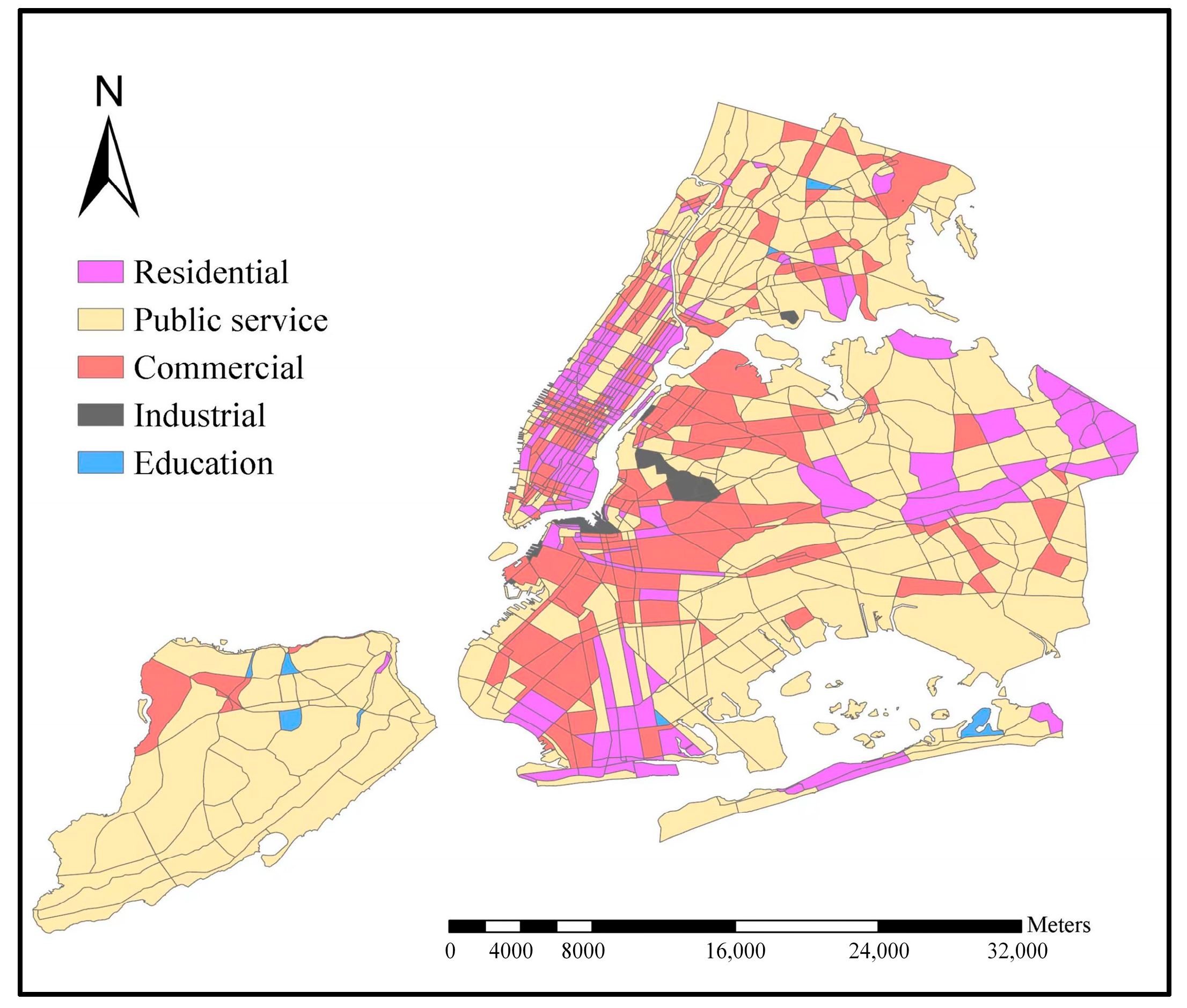
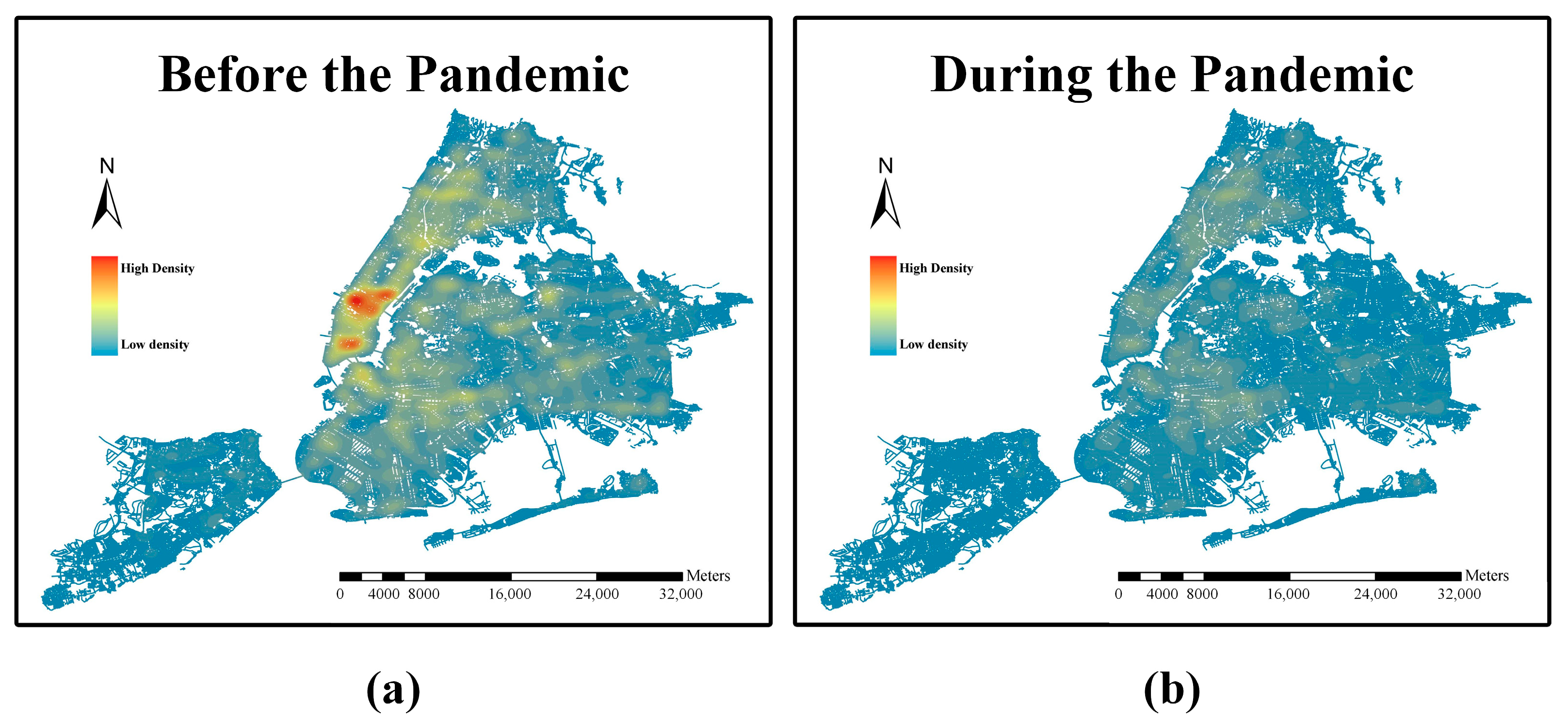

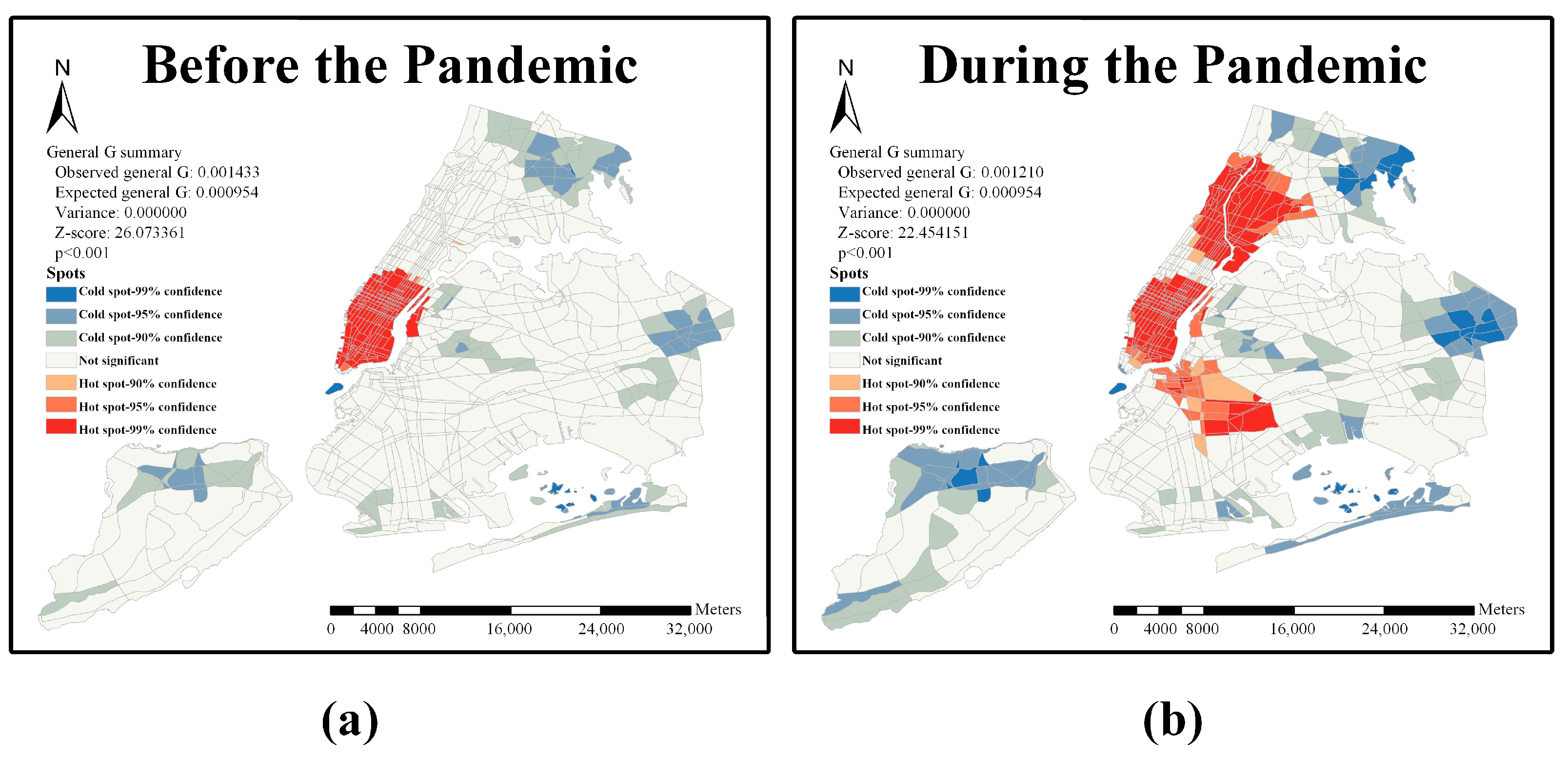

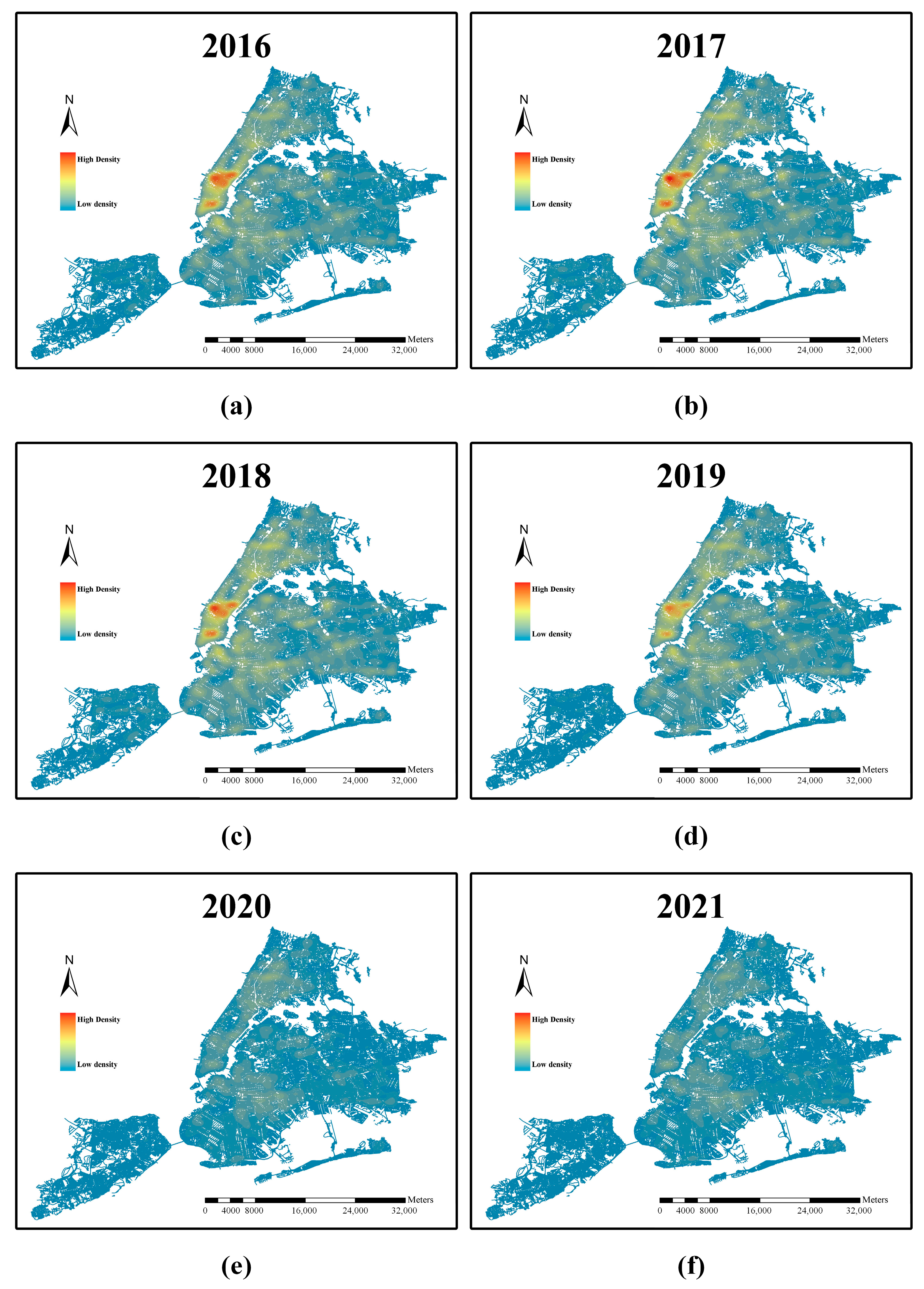
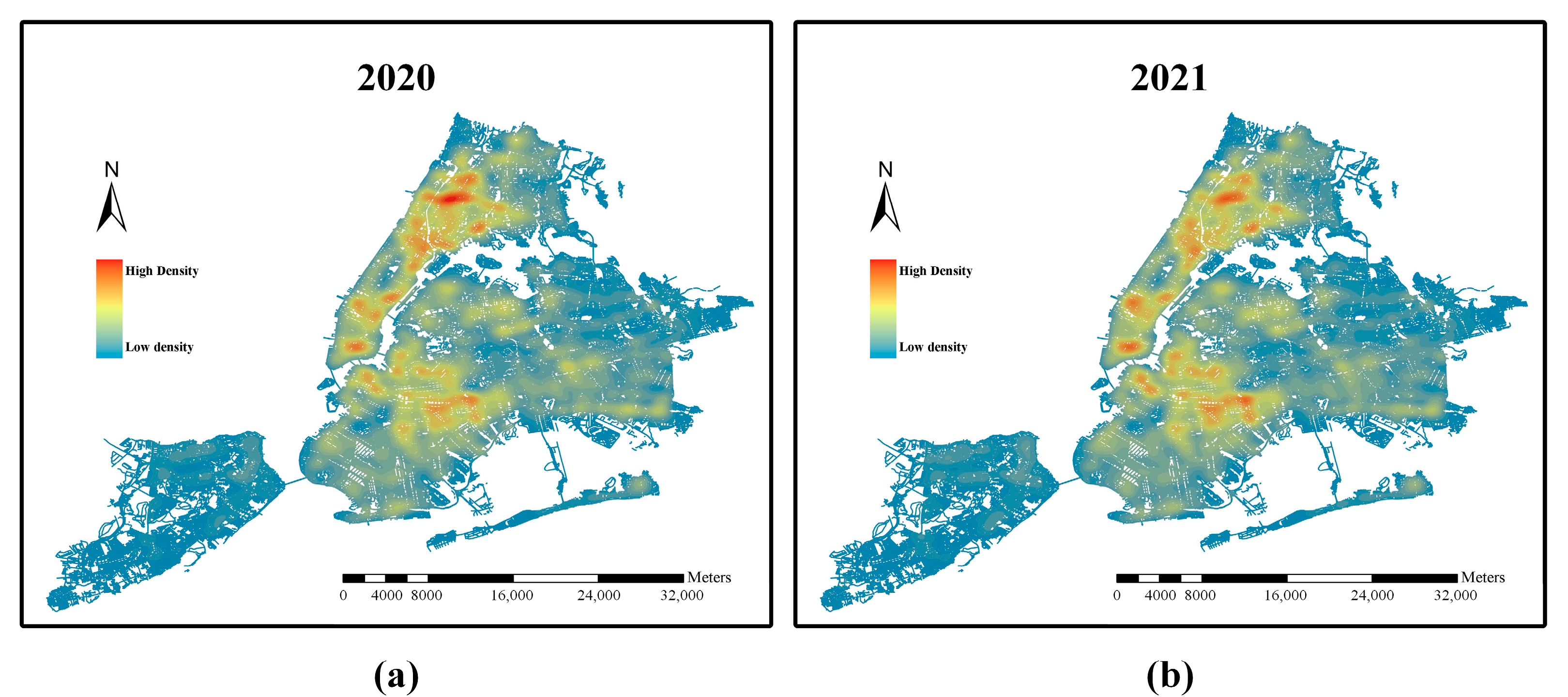




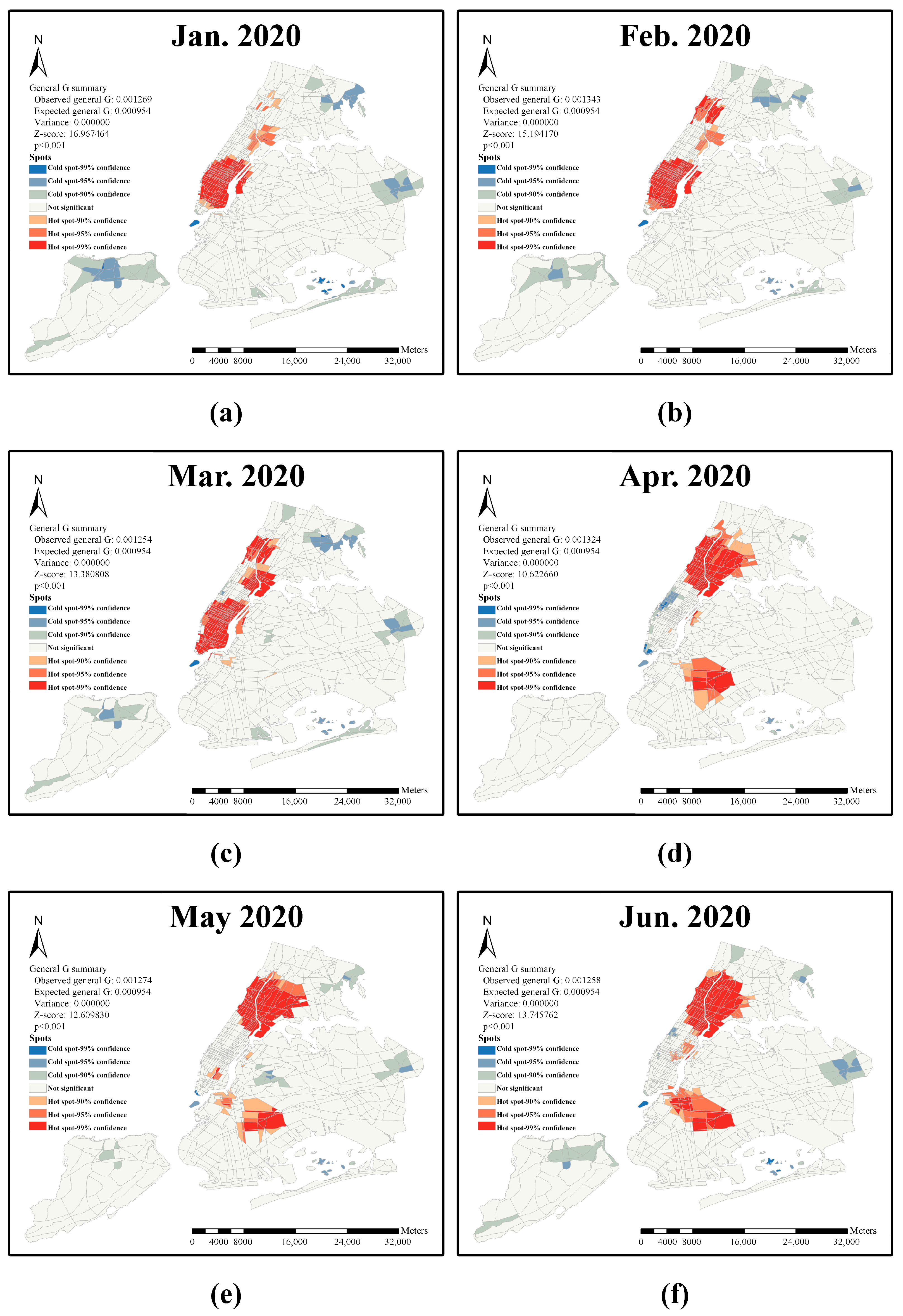
Disclaimer/Publisher’s Note: The statements, opinions and data contained in all publications are solely those of the individual author(s) and contributor(s) and not of MDPI and/or the editor(s). MDPI and/or the editor(s) disclaim responsibility for any injury to people or property resulting from any ideas, methods, instructions or products referred to in the content. |
© 2024 by the authors. Licensee MDPI, Basel, Switzerland. This article is an open access article distributed under the terms and conditions of the Creative Commons Attribution (CC BY) license (https://creativecommons.org/licenses/by/4.0/).
Share and Cite
Zhang, H.; Ci, Y.; Huang, Y.; Wu, L. The Effect of the COVID-19 Pandemic on the Distribution of Traffic Accident Hotspots in New York City. Sustainability 2024, 16, 3440. https://doi.org/10.3390/su16083440
Zhang H, Ci Y, Huang Y, Wu L. The Effect of the COVID-19 Pandemic on the Distribution of Traffic Accident Hotspots in New York City. Sustainability. 2024; 16(8):3440. https://doi.org/10.3390/su16083440
Chicago/Turabian StyleZhang, Hengyi, Yusheng Ci, Yikang Huang, and Lina Wu. 2024. "The Effect of the COVID-19 Pandemic on the Distribution of Traffic Accident Hotspots in New York City" Sustainability 16, no. 8: 3440. https://doi.org/10.3390/su16083440
APA StyleZhang, H., Ci, Y., Huang, Y., & Wu, L. (2024). The Effect of the COVID-19 Pandemic on the Distribution of Traffic Accident Hotspots in New York City. Sustainability, 16(8), 3440. https://doi.org/10.3390/su16083440







